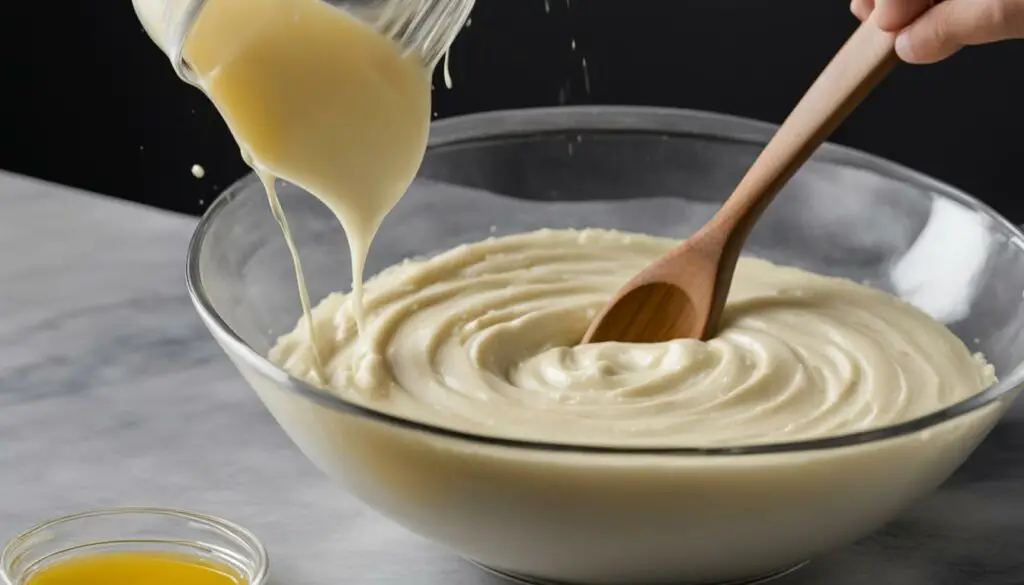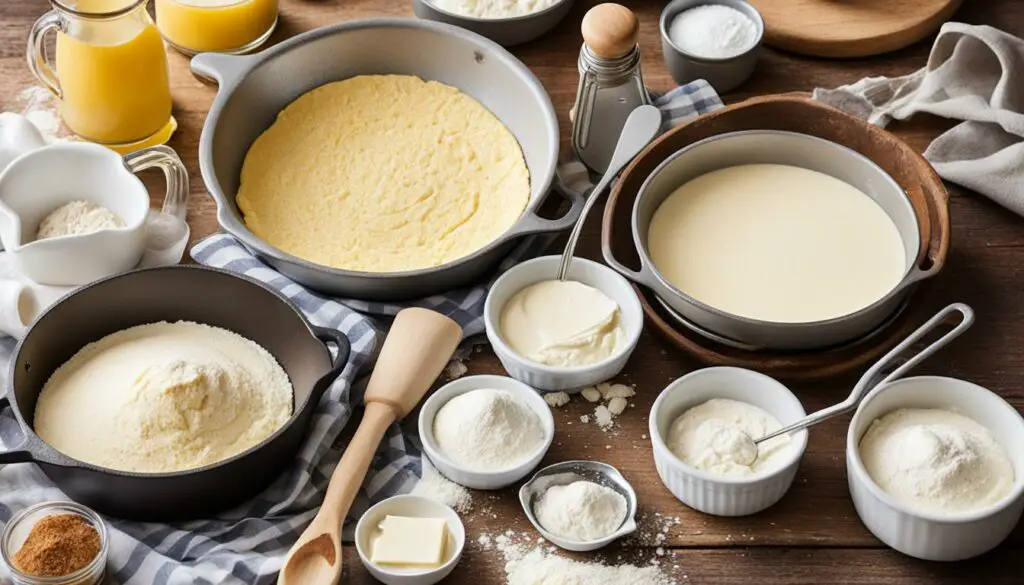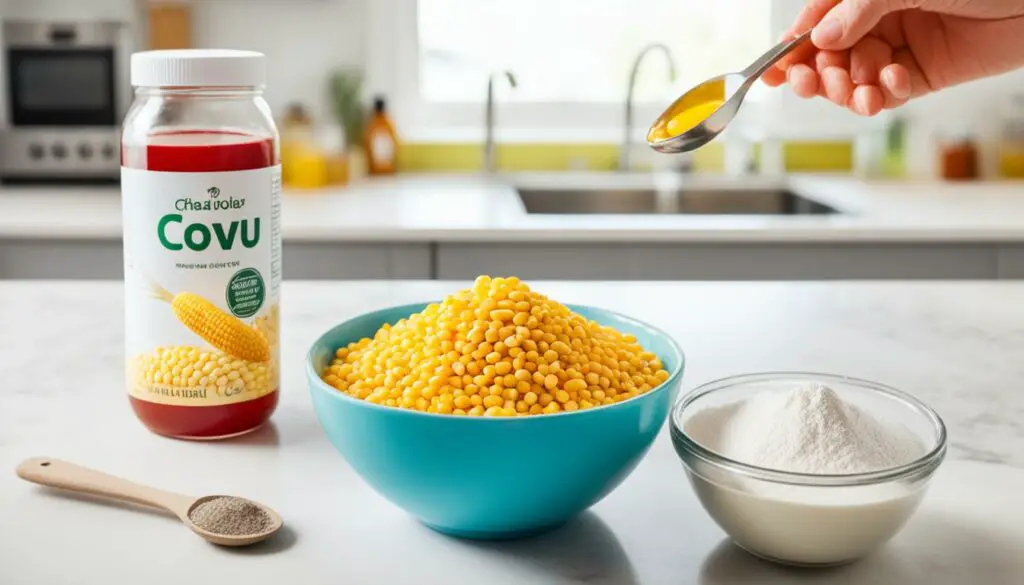Did you know that there are suitable substitutes for cream of tartar in baking recipes? Whether you’ve run out of cream of tartar or simply want to explore alternative options, you can still achieve delicious treats without this versatile ingredient. From leavening agents to stabilizing whipped egg whites, there are various alternatives that can provide similar results.
Table of Contents
Key Takeaways:
- There are several substitutes for cream of tartar in baking recipes.
- Lemon juice, white vinegar, baking powder, buttermilk, and yogurt can be used as alternatives in specific situations.
- A copper bowl can also help stabilize whipped egg whites without cream of tartar.
- Consider the specific role of cream of tartar in the recipe before choosing a substitute or omitting it.
- Experiment with different substitutes to find the best option for your baking needs.
Lemon Juice as a Cream of Tartar Substitute
When it comes to substituting cream of tartar, lemon juice is an excellent alternative. It works wonders in stabilizing whipped egg whites and preventing sugar crystallization in your baked goods. The natural acidity present in lemon juice provides the necessary chemical reaction, allowing you to achieve those perfect stiff peaks in recipes like meringue.
In order to replace cream of tartar with lemon juice, simply use an equal amount of lemon juice as called for in the original recipe. Whether you’re making a cream of tartar substitute recipe or just looking for a quick fix, lemon juice can seamlessly take its place. It’s also worth noting that you can use lemon juice instead of cream of tartar in syrups or frostings to prevent crystallization. Just remember to adjust the amount of liquid in the recipe accordingly.
With its refreshing and tangy flavor, lemon juice not only serves as a cream of tartar substitute but also adds a delightful twist to your culinary creations. So, the next time you find yourself out of cream of tartar, reach for that trusty bottle of lemon juice and keep baking!
White Vinegar as a Cream of Tartar Substitute

When it comes to stabilizing egg whites in recipes like soufflés and meringues, white vinegar can be a great substitute for cream of tartar. Just like cream of tartar, white vinegar is acidic and can help create stiff peaks in whipped egg whites. To use white vinegar as a substitute, simply replace an equal amount of cream of tartar with white vinegar as called for in the recipe.
However, it’s important to note that using white vinegar may slightly alter the taste and texture of baked goods, especially in recipes like cakes. Therefore, it’s best to use white vinegar as a substitute in recipes where the flavor won’t be significantly affected.
If you’re looking for a cream of tartar replacement option that’s readily available in most kitchens, white vinegar is a reliable choice. Just remember to adjust your recipe accordingly, and you’ll be able to enjoy delicious baked treats without the need for cream of tartar.
Why Does White Vinegar Work as a Substitute?
The acidity in white vinegar, similar to that of cream of tartar, helps stabilize whipped egg whites by promoting protein denaturation and coagulation. This process creates a stronger, more stable foam, allowing the egg whites to hold their shape even when exposed to heat during baking.
“White vinegar is a versatile ingredient that can add acidity to recipes while also providing the necessary stability for creating certain textures. When used as a substitute for cream of tartar, it can be a handy tool in the kitchen!”
In addition to its role in stabilizing egg whites, white vinegar can also help prevent sugar crystallization in syrups and frostings, similar to cream of tartar. Its acidic properties inhibit the formation of large sugar crystals, resulting in a smooth and creamy texture.
Baking with White Vinegar
Using white vinegar as a cream of tartar substitute doesn’t require any special techniques or adjustments. Simply follow the recipe as usual, but instead of adding cream of tartar, add an equal amount of white vinegar. Be sure to incorporate the white vinegar evenly into the recipe for optimal results.
If you’re concerned about the flavor impact of white vinegar, it’s best to use it in recipes where the taste won’t be prominent or where the other ingredients can mask its presence. Recipes like soufflés, meringues, and certain breads are great options for baking with white vinegar as a cream of tartar substitute.
Summary
When you find yourself without cream of tartar, white vinegar can step in as a reliable substitute. Its acidity helps stabilize whipped egg whites and prevents sugar crystallization, making it a versatile ingredient in the kitchen. Just remember to adjust the flavors and choose recipes where the taste of white vinegar won’t overpower other ingredients. With white vinegar as a cream of tartar replacement option, you can continue baking your favorite treats with confidence and creativity!
Baking Powder as a Cream of Tartar Substitute
In recipes that call for both baking soda and cream of tartar, you can easily substitute cream of tartar with baking powder. Baking powder is a combination of baking soda and cream of tartar, so it can provide the necessary leavening in your recipes without compromising the taste or texture of the final product.
To substitute cream of tartar with baking powder, follow this simple conversion:
| Cream of Tartar | Baking Powder |
|---|---|
| 1 teaspoon (3.5 grams) | 1.5 teaspoons (6 grams) |
For every 1 teaspoon (3.5 grams) of cream of tartar required in the recipe, use 1.5 teaspoons (6 grams) of baking powder as a substitute. This adjustment ensures that your recipe still achieves the desired rise and texture.
Baking powder is a versatile ingredient commonly found in most kitchens, making it a convenient cream of tartar replacement. It’s essential to note that this substitute is suitable for recipes that rely on the leavening properties of cream of tartar and baking soda, such as cookies, cakes, and quick breads.
So the next time you find yourself without cream of tartar, feel confident in using baking powder as a reliable substitute. Your baked treats will still turn out delicious and delightful!
Buttermilk as a Cream of Tartar Substitute

When it comes to baking, buttermilk can be a lifesaver in situations where cream of tartar is not available. This tangy and acidic ingredient can provide similar effects to cream of tartar in stabilizing and leavening, making it a suitable replacement in various recipes, especially in baked goods.
To use buttermilk as a substitute for cream of tartar, you need to make a slight adjustment to the recipe. For every 1/4 teaspoon (1 gram) of cream of tartar required, simply remove 1/2 cup (120 mL) of liquid from the recipe and replace it with an equal amount of buttermilk. This substitution works best in recipes where you can easily adjust the liquid content accordingly.
Buttermilk not only helps with stabilizing and leavening but also adds a delightful tanginess to baked goods. It contributes to the overall flavor profile, creating a unique taste that perfectly complements certain recipes. Additionally, buttermilk can enhance the texture of cakes, muffins, and bread, making them moist and tender.
If you’re worried about altering the taste or texture of your recipe, don’t be. Buttermilk is a versatile ingredient that can seamlessly replace cream of tartar without compromising the quality of your baked goods. So, go ahead and embrace the creamy goodness of buttermilk in your baking adventures.
To showcase the versatility of buttermilk as a cream of tartar substitute, here’s a table comparing the two:
| Criteria | Buttermilk | Cream of Tartar |
|---|---|---|
| Stabilizes whipped egg whites | Yes | Yes |
| Prevents sugar crystallization | Yes | Yes |
| Texture enhancement in baked goods | Yes | No |
| Tangy flavor addition | Yes | No |
| Availability | Widely available | May require specialized stores |
As the table illustrates, buttermilk can effectively replace cream of tartar in various aspects, making it a valuable ingredient in your kitchen. Its availability in most grocery stores makes it a convenient substitute for those times when cream of tartar is not on hand.
So, the next time you find yourself without cream of tartar, don’t fret. Reach for a carton of buttermilk and let its creamy acidity help you bake your way to deliciousness.
Yogurt as a Cream of Tartar Substitute
In certain recipes, yogurt can serve as an excellent alternative to cream of tartar. Like buttermilk, yogurt contains acidity, making it a suitable replacement for stabilizing and leavening baked goods. To use yogurt as a substitute, you’ll need to adjust its consistency to match that of buttermilk.
To thin out yogurt, simply mix it with a bit of milk until it reaches a similar texture to buttermilk. For every 1/4 teaspoon (1 gram) of cream of tartar required in the recipe, remove 1/2 cup (120 mL) of liquid and replace it with 1/2 cup (120 mL) of thinned-out yogurt. This substitution works particularly well in baked goods and can impart a delightful tanginess to the final product.
Yogurt Cream of Tartar Substitute Conversion
| Cream of Tartar (1/4 tsp) | Thinned-out Yogurt (1/2 cup) |
|---|---|
| 1 gram | 120 mL |
Using a Copper Bowl to Stabilize Egg Whites

If you’re looking for an alternative to cream of tartar when stabilizing whisked egg whites, consider using a copper bowl instead. While scientific research is still ongoing, experts believe that the copper ions present in the bowl interact with the proteins in the egg whites, resulting in a stable foam and preventing overheating.
The use of a copper bowl can help stabilize egg whites without the need for cream of tartar. This natural method is particularly beneficial for those who prefer to avoid or don’t have access to cream of tartar. However, it’s important to be aware that copper bowls can be more expensive and require special care to maintain their effectiveness.
To use a copper bowl, follow these simple steps:
- Select a clean and dry copper bowl. Ensure that there is no residue or grease on the surface, as this can affect the stability of the egg whites.
- Crack the eggs and separate the yolks from the whites. Carefully pour the egg whites into the copper bowl.
- Using a whisk or an electric mixer, beat the egg whites until they reach the desired consistency. The copper bowl should help create and maintain a stable foam without the need for cream of tartar.
Remember, using a copper bowl is a traditional method that has been used for centuries. While it may not be as widely known or accessible as cream of tartar, it can be a valuable tool in your baking arsenal. So, next time you’re whipping up a meringue or soufflé, give a copper bowl a try and marvel at the fluffy results.
And speaking of results, take a look at the table below for a quick comparison of using a copper bowl versus cream of tartar:
| Factors | Using a Copper Bowl | Cream of Tartar |
|---|---|---|
| Stability of Egg Whites | Stabilizes egg whites without cream of tartar | Stabilizes egg whites |
| Ingredient Accessibility | May require a special copper bowl | Widely available |
| Cost | Can be more expensive | Relatively inexpensive |
| Special Care | Requires proper cleaning and maintenance | No special care needed |
As you can see, using a copper bowl as a cream of tartar substitute offers a unique alternative that may be worth exploring in your baking endeavors.
Can I Use Corn Syrup as a Cream of Tartar Substitute?

When it comes to finding a substitute for cream of tartar, you may wonder if corn syrup can do the trick. While corn syrup can have similar effects to cream of tartar, it’s important to consider the nutritional implications before using it as a substitute.
Corn syrup can help prevent sugar crystallization, just like cream of tartar. However, it’s important to note that corn syrup is high in sugar and calories. This may not make it the healthiest option, especially if you’re looking for a low-sugar or low-calorie alternative.
Despite its drawbacks, there may be situations where using corn syrup as a cream of tartar substitute can work well. If you don’t have any other options on hand, using a small amount of corn syrup in sweet treats can help prevent sugar crystallization.
For a healthier alternative, consider exploring other substitutes mentioned in this article, such as lemon juice, white vinegar, baking powder, buttermilk, or yogurt. These options can provide similar effects without the high sugar content of corn syrup.
Remember, the choice to use corn syrup as a substitute ultimately depends on your specific preferences and dietary needs. It’s always a good idea to experiment with different substitutes and find the best option for your desired outcome.
Cream of Tartar Substitutes Comparison
| Substitute | Usage | Effect |
|---|---|---|
| Lemon Juice | Stabilizing whipped egg whites, preventing sugar crystallization | Provides acidity for stiff peaks and prevents crystallization |
| White Vinegar | Stabilizing egg whites in soufflés and meringues | Acidity for creating stiff peaks |
| Baking Powder | Leavening agent in recipes | Combination of baking soda and cream of tartar for leavening |
| Buttermilk | Stabilizing and leavening in baked goods | Acidity for similar effects to cream of tartar |
| Yogurt | Stabilizing and providing acidity in baked goods | Thinned-out yogurt for tangy flavor and similar effects to cream of tartar |
| Corn Syrup | Preventing sugar crystallization | Similar effect to cream of tartar, but high in sugar |
Stay informed and explore different options to bake without cream of tartar. For further information, check out this article on cream of tartar substitutes.
Can I Leave Cream of Tartar Out of a Recipe?
In some recipes, it may be possible to omit cream of tartar without dire consequences. For example, if you’re using cream of tartar to stabilize whipped egg whites, you can leave it out and still achieve good results. Similarly, if you’re making syrups, frostings, or icings and using cream of tartar to prevent crystallization, you can omit it from the recipe without major issues. However, it’s important to note that omitting cream of tartar in recipes that require a leavening agent may result in a different texture and rise. It’s best to consider the specific role of cream of tartar in the recipe before deciding to leave it out.
When omitting cream of tartar from a recipe, it’s important to understand its purpose. Cream of tartar acts as a stabilizer and can help achieve desirable texture and rise in certain baked goods. If a recipe calls for cream of tartar as a leavening agent, it’s advisable to find a suitable substitute or adjust the recipe to account for the lack of cream of tartar.
Conclusion
In conclusion, baking without cream of tartar is not only possible but also offers a variety of alternatives to achieve similar results. When you find yourself without cream of tartar, don’t worry! You can still create delicious baked goods by using suitable substitutes or by omitting it from specific recipes.
Experimenting with different ingredients like lemon juice, white vinegar, baking powder, buttermilk, and yogurt can provide the acidity and stability needed in various baking scenarios. Each substitute offers its unique benefits, allowing you to tailor your recipe based on the specific effects of cream of tartar.
However, there are instances where you can confidently leave out cream of tartar without dire consequences, especially in recipes where it serves as a stabilizer for whipped egg whites or a preventative agent for crystallization. By understanding the role of cream of tartar in your recipe, you can make informed decisions about whether to substitute or omit it.
So, the next time you’re faced with a cream of tartar dilemma, remember these baking tips and explore the possibilities. Whether you choose to use a substitute or go cream of tartar-free, happy baking!
FAQ
Can you make a recipe without cream of tartar?
Yes, you can! There are several suitable substitutes you can use in place of cream of tartar.
What can I use as a cream of tartar substitute?
Lemon juice, white vinegar, baking powder, buttermilk, and yogurt can all be used as alternatives to cream of tartar in specific situations.
How can I substitute cream of tartar with lemon juice?
To substitute cream of tartar with lemon juice, use an equal amount of lemon juice as called for in the recipe.
Can I use white vinegar instead of cream of tartar?
Yes, you can use white vinegar as a substitute for cream of tartar in recipes that require stabilizing egg whites.
How can I substitute cream of tartar with baking powder?
To substitute cream of tartar with baking powder, use 1.5 teaspoons (6 grams) of baking powder for every 1 teaspoon (3.5 grams) of cream of tartar required in the recipe.
Can buttermilk be used as a cream of tartar substitute?
Yes, buttermilk can be used as a substitute for cream of tartar in recipes, especially in baked goods.
How can I substitute cream of tartar with yogurt?
To use yogurt as a substitute for cream of tartar, thin it out with a bit of milk to match the consistency of buttermilk.
Can I use a copper bowl to stabilize egg whites instead of cream of tartar?
Yes, using a copper bowl can help stabilize whipped egg whites without the need for cream of tartar.
Can I use corn syrup as a cream of tartar substitute?
While corn syrup can help prevent sugar crystallization like cream of tartar, it may not be the healthiest option due to its high sugar and calorie content.
Can I leave cream of tartar out of a recipe?
In some recipes, you can omit cream of tartar without major consequences, but it’s best to consider its specific role in the recipe before deciding to leave it out.
Source Links
- https://www.healthline.com/nutrition/cream-of-tartar-substitutes
- https://twosugarbugs.com/meringue-cookies/
- https://www.hummingbirdhigh.com/2020/12/snickerdoodle-recipe-without-cream-of-tartar.html
See also:
Leave a Reply